Volvo V90 Cross Country 2018 User Manual

OWNER'S MANUAL

VÄLKOMMEN!
We trust that you will enjoy many years of safe driving in your Volvo, an automobile designed with your safety and comfort in mind. To help get the most from your Volvo, we urge you to familiarize yourself with the instructions and maintenance information in this owner’s manual. The owner’s manual can also be found in a mobile app (Volvo manual) and on Volvo Car’s support site at support.volvocars.com.
We also urge you and your passengers to wear seat belts at all times in this (or any other) vehicle. And, of course, please do not operate a vehi-
cle if you may be affected by alcohol, medication or any impairment that could hinder your ability to drive.
Your Volvo is designed to meet all applicable federal safety and emission standards. If you have any questions regarding your vehicle, please contact your Volvo retailer or see the article "Contacting Volvo" for information on getting in touch with Volvo in the United States and Canada.

TABLE OF CONTENTS
INTRODUCTION
Finding owner's information |
14 |
On-board digital owner's manual |
15 |
Navigating in the digital owner's manual |
16 |
Owner's manual in mobile devices |
18 |
Additional information about your vehicle |
19 |
Using the owner's manual |
20 |
Crash event data |
22 |
Options, accessories and the On- |
23 |
board Diagnostic (OBDII) socket |
|
Volvo ID |
25 |
Volvo and the environment |
26 |
IntelliSafe—driver support |
26 |
Sensus |
28 |
Owner's manual and the environment |
31 |
Glass |
31 |
Center display overview |
32 |
Using the center display |
34 |
Navigating in the center display's views |
38 |
Symbols in the center display status bar |
43 |
Changing center display settings |
43 |
Function view buttons |
45 |
Using the center display keyboard |
47 |
Changing settings in different types |
52 |
of apps |
|
Volvo Structural Parts Statement |
52 |
Driver distraction |
53 |
Technician certification |
54 |
Contacting Volvo |
54 |
Volvo Roadside Assistance |
55 |
SAFETY
General safety information |
58 |
Safety during pregnancy |
58 |
Whiplash protection system |
59 |
Occupant safety |
60 |
Reporting safety defects |
61 |
Recall information |
62 |
Seat belts |
62 |
Seat belt pretensioners |
63 |
Buckling and unbuckling seat belts |
64 |
Door and seat belt reminders |
66 |
Airbag system |
67 |
Driver/passenger side airbags |
67 |
Occupant weight sensor |
70 |
Side impact airbags |
74 |
Inflatable curtains |
75 |
Safety mode |
75 |
Starting or moving a vehicle in safety |
76 |
mode |
|
Child safety |
77 |
Child restraints |
79 |
Infant seats |
80 |
Convertible seats |
82 |
Booster cushions |
85 |
ISOFIX/LATCH lower anchors |
86 |
Lower child seat attachment points |
87 |
2

Top tether anchors |
88 |
Integrated booster cushion* |
89 |
Raising the integrated booster cushion* |
90 |
Stowing the integrated booster cushion* |
92 |
INSTRUMENTS AND CONTROLS
Instruments and controls |
96 |
Instrument panel |
97 |
Instrument panel settings |
100 |
Indicator symbols in the instrument panel |
101 |
Warning symbols in the instrument panel |
103 |
Ambient temperature sensor |
104 |
Clock |
105 |
Fuel gauge |
106 |
Instrument panel licenses |
106 |
Instrument panel App menu |
111 |
Using the instrument panel App menu |
112 |
Messages in the instrument panel |
113 |
and center display |
|
Handling messages in the instru- |
114 |
ment panel and center display |
|
Handling messages stored from the |
116 |
instrument panel and center display |
|
Head-up display (HUD)* |
117 |
Voice control |
120 |
Using voice commands |
121 |
Voice control settings |
122 |
Voice control for cell phones |
122 |
Voice control for radio and media |
123 |
Climate system voice commands |
124 |
Navigation system voice commands |
125 |
Seats |
125 |
Manually operated front seats |
126 |
Power front seats* |
126 |
Adjusting power front seats* |
127 |
Using the power seat memory function* |
127 |
Multifunctional front seats* |
128 |
Adjusting function settings in the |
129 |
multifunctional front seats* |
|
Adjusting the passenger's seat from |
132 |
the driver's seat* |
|
Rear seats |
133 |
Adjusting the second row head restraints |
133 |
Folding down the rear seat backrests |
134 |
Steering wheel |
136 |
Adjusting the steering wheel |
137 |
Lighting panel and controls |
138 |
Parking lights |
139 |
Low beam headlights |
140 |
High and low beam headlights |
141 |
Daytime Running Lights (DRL) |
142 |
Active Bending Lights* |
143 |
Front fog lights* |
144 |
Rear fog light |
145 |
Brake lights |
145 |
Hazard warning flashers |
146 |
3

Using turn signals |
146 |
Passenger compartment lighting |
147 |
Home safe lighting |
149 |
Approach lighting |
150 |
Using the windshield wipers |
150 |
Activating/deactivating the rain sensor |
151 |
Windshield and headlight washers |
152 |
Tailgate window wiper and washer |
153 |
Power windows |
153 |
Operating the power windows |
154 |
Using sun curtains* |
155 |
Adjusting the power door mirrors |
155 |
Rearview mirror |
157 |
Compass |
158 |
Calibrating the compass |
158 |
Laminated panoramic roof* |
159 |
Operating the laminated panoramic roof* |
160 |
HomeLink® Wireless Control System* |
163 |
Programming the HomeLink® Wire- |
164 |
less Control System* |
|
Trip computer |
167 |
Displaying trip computer information |
168 |
Displaying trip statistics |
169 |
Settings view |
170 |
Categories in Settings view |
171 |
Changing system settings in Set- |
173 |
tings view |
|
Resetting the settings view |
174 |
Driver profiles |
174 |
Selecting a driver profile |
175 |
Editing a driver profile |
176 |
Linking a remote key to a driver profile |
176 |
Importing/exporting a driver profile |
177 |
from/to a USB flash drive |
|
Changing settings in apps |
178 |
Resetting user data when the vehicle |
179 |
changes owners |
|
CLIMATE
Climate control system |
182 |
Climate system sensors |
183 |
Perceived temperature |
183 |
Air quality |
184 |
Passenger compartment air filter |
185 |
Clean Zone Interior Package (CZIP)* |
185 |
Interior Air Quality System (IAQS)* |
185 |
Climate system controls |
186 |
Climate system controls in the center |
187 |
display |
|
Rear climate system controls on the |
188 |
tunnel console* |
|
Automatic climate control |
189 |
Air conditioning |
190 |
Setting the temperature |
190 |
Setting the blower speed |
193 |
Defrosting windows and mirrors |
194 |
Turning recirculation on and off |
196 |
Air distribution |
197 |
Adjusting air distribution |
198 |
Opening/closing/directing air vents |
198 |
Air distribution table |
200 |
Turning seat heating* on and off |
202 |
Turning front seat ventilation* on and off |
203 |
4

|
|
LOADING AND STORAGE |
|
Turning steering wheel heating* on |
204 |
Passenger compartment storage spaces |
208 |
and off |
|
Tunnel console |
209 |
|
|
||
|
|
Electrical sockets |
210 |
|
|
Using the glove compartment |
213 |
|
|
Sun visors |
214 |
|
|
Loading |
214 |
|
|
Load anchoring eyelets |
216 |
|
|
Grocery bag holder |
217 |
|
|
Ski hatch |
218 |
|
|
Cargo compartment cover* |
218 |
|
|
Cargo net |
220 |
|
|
Steel cargo grid* |
222 |
|
|
|
|
LOCKS AND ALARM
Locks and remote keys |
226 |
Remote key |
226 |
Remote key's range |
228 |
Red Key* |
229 |
Antenna locations for the start and |
230 |
lock system |
|
Locking/unlocking from outside the |
230 |
vehicle |
|
Locking and unlocking confirmation |
232 |
Locking/unlocking from inside the |
234 |
vehicle |
|
Locking/unlocking the tailgate |
235 |
Private (valet) locking |
236 |
Detachable key blade |
237 |
Locking/unlocking with the detacha- |
238 |
ble key blade |
|
Power tailgate* |
239 |
Foot movement tailgate operation* |
242 |
Changing the remote key's battery |
243 |
Immobilizer |
245 |
Child safety locks |
246 |
Alarm |
247 |
Automatically arming/disarming the |
248 |
alarm |
|
Deactivating the alarm without a |
249 |
functioning remote key |
|
5

|
DRIVER SUPPORT |
|
Start and lock system type designations 249 |
Driver support systems |
252 |
|
Adjustable steering force* |
252 |
|
Roll stability control (RSC) |
253 |
|
Electronic Stability Control (ESC) |
253 |
|
Electronic Stability Control (ESC) |
254 |
|
sport mode |
|
|
Electronic Stability Control (ESC) |
255 |
|
symbols and messages |
|
|
Speed limiter (SL)* |
257 |
|
Starting and activating the Speed |
258 |
|
Limiter (SL)* |
|
|
Changing a Speed Limiter (SL)* |
258 |
|
maximum speed |
|
|
Deactivating/reactivating the Speed |
259 |
|
Limiter* |
|
|
Turning the Speed Limiter* off |
260 |
|
Automatic Speed Limiter (ASL)* |
260 |
|
Activating/deactivating the |
262 |
|
Automatic Speed Limiter (ASL)* |
|
|
Changing tolerance for the |
262 |
|
Automatic Speed Limiter |
|
|
Cruise Control (CC) |
263 |
|
Starting and activating Cruise Control |
264 |
|
Changing Cruise Control (CC) speed |
265 |
|
Deactivating/resuming Cruise |
266 |
|
Control (CC) |
|
|
Turning Cruise Control off |
267 |
|
|
|
Distance Alert* |
268 |
Using Distance Alert* |
269 |
Distance Alert* limitations |
270 |
Adaptive Cruise Control (ACC)* |
270 |
Starting and activating Adaptive |
273 |
Cruise Control (ACC)* |
|
Changing Adaptive Cruise Control |
274 |
(ACC) speed |
|
Setting an Adaptive Cruise Control |
275 |
(ACC) time interval |
|
Deactivating/resuming Adaptive |
276 |
Cruise Control (ACC) |
|
Passing Assistance with Adaptive |
278 |
Cruise Control (ACC)* or Pilot Assist* |
|
Changing target vehicles and auto- |
279 |
matic braking with Adaptive Cruise |
|
Control (ACC) |
|
Adaptive Cruise Control (ACC) - limi- |
280 |
tations |
|
Switching between Cruise Control |
281 |
(CC) and Adaptive Cruise Control (ACC)* |
|
Adaptive Cruise Control (ACC) sym- |
282 |
bols and messages |
|
Pilot Assist* |
284 |
Starting and activating Pilot Assist |
287 |
Changing Pilot Assist speed |
289 |
Setting a Pilot Assist time interval |
290 |
Deactivating/resuming Pilot Assist |
292 |
6

Changing target vehicles and auto- |
294 |
matic braking with Pilot Assist |
|
Pilot Assist limitations |
295 |
Pilot Assist symbols and messages |
297 |
Driver support system radar sensor |
298 |
Radar sensor limitations |
300 |
Radar sensor - type approval |
303 |
Driver support system camera |
303 |
Camera limitations |
304 |
City Safety™ |
307 |
City Safety warning level settings |
309 |
Detecting obstructions with City Safety |
311 |
City Safety in crossing traffic |
313 |
City Safety when evasive action is |
314 |
not possible |
|
City Safety limitations |
314 |
City Safety symbols and messages |
317 |
Rear Collision Warning (RCW) |
318 |
Blind Spot Information (BLIS)* |
319 |
Blind Spot Information (BLIS)* On/Off |
320 |
Blind Spot Information (BLIS)* limitations |
321 |
Cross Traffic Alert (CTA)* |
321 |
Activating/deactivating Cross Traffic |
322 |
Alert (CTA)* |
|
Cross Traffic Alert (CTA)* limitations |
323 |
Blind Spot Information (BLIS)* with |
325 |
Cross Traffic Alert (CTA)* symbols |
|
and messages |
|
Road Sign Information (RSI)* |
326 |
Road Sign Information (RSI)* operation |
327 |
Road Sign Information (RSI)* limitations |
328 |
Driver Alert Control (DAC) |
329 |
Using Driver Alert Control (DAC) |
330 |
Driver Alert Control limitations |
330 |
Driving lane assistance |
330 |
Activating/deactivating Lane |
332 |
Keeping Aid (LKA) |
|
Driving lane assistance symbols and |
334 |
messages |
|
Steering assistance when there is a |
336 |
risk of a collision |
|
Steering assistance symbols and |
337 |
messages |
|
Steering assist with run-off mitigation |
338 |
Steering assistance in oncoming traffic |
339 |
Steering assistance during collision |
341 |
risks from behind |
|
Park Assist* |
342 |
Activating/deactivating Park Assist |
344 |
Park Assist limitations |
344 |
Park Assist symbols and messages |
346 |
Park Assist Camera (PAC)* |
347 |
Park Assist Camera (PAC)* trajectory |
349 |
lines and fields |
|
Starting the Park Assist Camera (PAC)* |
351 |
Park Assist Camera (PAC)* limitations |
352 |
Park Assist Camera (PAC)* - sym- |
354 |
bols and messages |
|
Park Assist Pilot (PAP)* |
356 |
Using Park Assist Pilot (PAP)* |
357 |
Park Assist Pilot (PAP)* limitations |
360 |
Park Assist Pilot (PAP)* symbols and |
362 |
messages |
|
7

STARTING AND DRIVING
Starting and driving |
364 |
Ignition modes |
364 |
Starting the engine |
365 |
Turning the engine off |
367 |
Jump starting |
368 |
Automatic transmission |
369 |
Gear selector positions |
370 |
Gear shift indicator |
371 |
Shiftlock |
372 |
Steering wheel paddles* |
373 |
Start/Stop |
374 |
Using the Start/Stop function |
374 |
Conditions for Start/Stop |
376 |
Drive modes* |
377 |
ECO drive mode |
380 |
Leveling control* and suspension |
382 |
All Wheel Drive (AWD) |
383 |
Brake functions |
383 |
Brakes |
383 |
Emergency brake lights |
385 |
Brake assist system |
386 |
Braking effect after a collision |
386 |
Parking brake |
386 |
Using the parking brake |
387 |
Parking brake malfunctions |
389 |
Hill Start Assist |
389 |
Auto-hold brake function |
390 |
Low Speed Control (LSC)* |
390 |
Hill Descent Control (HDC) |
391 |
Driving through standing water |
392 |
Overheating the engine and transmission |
393 |
Battery drain |
394 |
Before a long distance trip |
394 |
Winter driving |
395 |
Opening/closing the fuel filler door |
396 |
Fuel |
397 |
Octane rating |
398 |
Emission controls |
399 |
Driving economically |
399 |
Retractable towbar* |
400 |
Driving with a trailer |
402 |
Trailer Stability Assist (TSA) |
405 |
Towing eyelet |
406 |
Towing recommendations |
407 |
INFOTAINMENT
The infotainment system |
412 |
Apps (applications) |
412 |
Sound settings |
413 |
Radio |
414 |
Changing and searching for radio |
414 |
stations |
|
RBDS radio |
416 |
HD Radio™reception |
416 |
Switching HD Radio on and off |
417 |
HD Radio sub-channels |
418 |
HD Radio limitations |
419 |
SiriusXM® Satellite radio* |
419 |
Using SiriusXM® Satellite radio* |
420 |
SiriusXM® Satellite radio* settings |
422 |
SiriusXM Travel Link* |
423 |
SiriusXM Travel Link - Weather |
424 |
SiriusXM Travel Link - Alerts |
425 |
SiriusXM Travel Link - Fuel |
426 |
SiriusXM Travel Link - Sports |
427 |
Radio settings |
428 |
Media player |
429 |
Playing media |
429 |
Gracenote |
432 |
Media searches |
432 |
8

CD (media) player* |
433 |
Streaming media through a Blue- |
433 |
tooth connection |
|
Connecting a Bluetooth® device |
434 |
Playing media through the USB socket |
434 |
Connecting a device via the USB socket |
434 |
Video |
435 |
Media sound settings |
435 |
Apple CarPlay |
436 |
Apple CarPlay settings |
438 |
Android auto* |
438 |
Android Auto* settings |
440 |
Media player technical data |
440 |
Phone |
442 |
Pairing a cell phone |
443 |
Connecting/disconnecting a cell phone |
444 |
Handling phone calls |
445 |
Handling text messages |
446 |
Managing the phone book |
447 |
Phone settings |
448 |
Text message settings |
448 |
Bluetooth settings |
448 |
Internet connected vehicle |
449 |
Connecting to the Internet |
450 |
Tethering (Wi-Fi sharing) |
451 |
Internet connection troubleshooting |
452 |
Deleting Wi-Fi networks |
452 |
Wi-Fi technology and security |
453 |
Vehicle modem settings |
453 |
Downloading, updating and uninstal- |
454 |
ling apps |
|
Infotainment system license information |
455 |
Terms, conditions and confidentiality |
459 |
WHEELS AND TIRES
Tires |
462 |
Tire direction of rotation |
464 |
Tread wear indicator |
464 |
Checking tire inflation pressure |
465 |
Tire Pressure Monitoring System (TPMS) |
466 |
Checking tire inflation pressure |
468 |
Reinflating tires equipped with the |
469 |
Tire Pressure Monitoring System (TPMS) |
|
Calibrating the Tire Pressure |
470 |
Monitoring System (TPMS) |
|
Tire sealing system |
471 |
Using the tire sealing system |
473 |
Inflating a tire with the tire sealing |
477 |
system compressor |
|
Changing tires |
478 |
Removing a wheel |
479 |
Installing a wheel |
480 |
Wheel bolts |
481 |
Spare tire |
481 |
Snow tires and chains |
483 |
Tools |
483 |
Jack |
484 |
Wheel (rim) designations |
484 |
Tire sidewall designations |
485 |
Tire terminology |
486 |
9

Loading specifications |
487 |
Uniform Tire Quality Grading |
488 |
MAINTENANCE AND SERVICING
Volvo's service program |
492 |
Vehicle status |
494 |
Booking service and repairs |
494 |
Remote updates |
497 |
System updates |
497 |
Hoisting the vehicle |
499 |
Opening and closing the hood |
501 |
Engine compartment overview |
502 |
Engine oil |
503 |
Checking and refilling engine oil |
504 |
Refilling coolant |
505 |
Climate system service |
506 |
Replacing bulbs |
506 |
Replacing low beam headlight bulbs |
508 |
Replacing High Beam headlight bulbs |
509 |
Replacing front parking light bulbs |
510 |
Replacing front turn signal bulbs |
510 |
Replacing backup lights |
511 |
Replacing the rear fog light |
512 |
Bulb specifications |
512 |
Windshield wipers in the service position |
513 |
Replacing wiper blades |
514 |
Refilling the windshield washer fluid |
515 |
reservoir |
|
Start battery |
516 |
Battery symbols |
518 |
Support battery |
519 |
Fuses |
520 |
Replacing fuses |
521 |
Fuses in the engine compartment |
522 |
Fuses in the passenger compartment |
526 |
Fuses in the cargo compartment |
530 |
Cleaning the exterior |
533 |
Polishing and waxing |
535 |
Corrosion protection |
536 |
Cleaning the interior |
536 |
Cleaning the center display |
538 |
Paint damage |
539 |
Touching up paint damage |
540 |
10

SPECIFICATIONS |
|
INDEX |
|
Label information |
542 |
Index |
557 |
Dimensions |
545 |
|
|
Weights |
547 |
|
|
Engine specifications |
550 |
|
|
Engine oil specifications and volume |
552 |
|
|
Coolant specifications |
552 |
|
|
Transmission fluid specification and |
553 |
|
|
volume |
|
|
|
Brake fluid specification and volume |
553 |
|
|
Fuel tank volume |
553 |
|
|
Air conditioning refrigerant |
554 |
|
|
Tire inflation pressure table |
555 |
|
|
|
|
|
|
11


INTRODUCTION
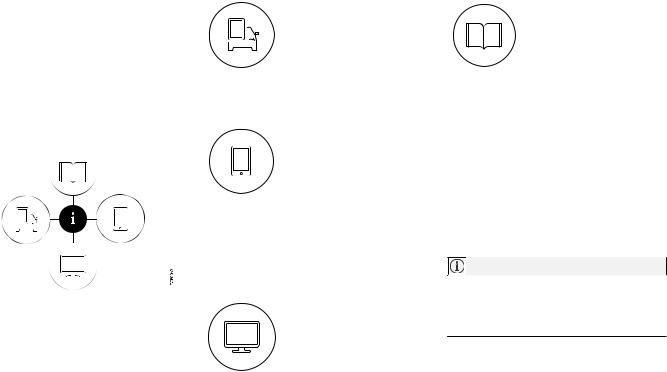
INTRODUCTION
Finding owner's information
Owner's information is available in several different formats in both digital and printed form. The owner's manual is available on the vehicle's center display, as a mobile app and on Volvo's support website.
There is also a Quick Guide in the glove compartment as well as a printed supplement to the owner's manual containing information about e.g., fuses, specifications, etc. A complete printed owner's manual can also be ordered.
The vehicle's center display
In the center display, pull down Top view and tap Owner's
manual. This gives you access
to visual navigation with exterior and interior images of the vehicle. The information is searchable and is divided into catego-
ries.
Mobile app
In App Store or Google Play, search for "Volvo Manual." Download the app to a smartphone or tablet and select a vehicle model. The app contains instructive videos and offers visual navigation, includ-
ing interior and exterior images of the vehicle. Navigation between the various articles in the owner's manual is designed to provide easy access to the information and the information is searchable.
Volvo Cars' support site
Go to support.volvocars.com and select your country. Owner's manuals are available here online and in PDF format. Volvo Cars' support site also contains instructional videos and additional information
about your vehicle and owning a Volvo.
Printed owner's information
The glove compartment contains a printed supplement to the owner’s manual containing information about fuses and specifications as well as a summary of other important and practical information.
A printed Quick Guide can also be found in the glove compartment containing useful information about the most commonly used features and functions in your vehicle.
Other printed owner's information may also be found in the vehicle, depending on options and/or accessories that the vehicle is equipped with.
A complete printed version of the owner's information (or a new owner's manual supplement) can be ordered through a Volvo retailer.
NOTE
If the content of the digital information in the center display and the printed information differ, the printed information always has precedence.
14
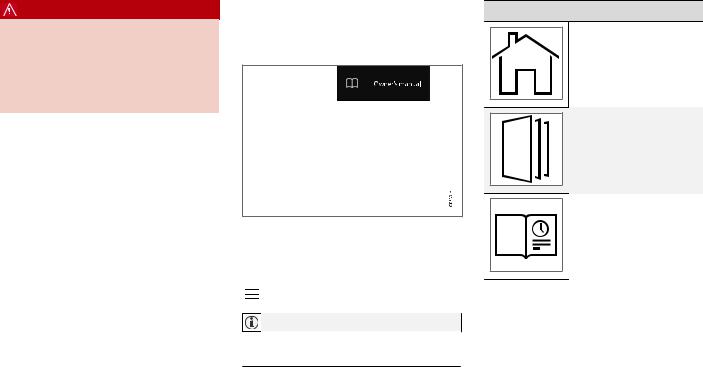
WARNING
The driver is always responsible for operating the vehicle in a safe manner and adhering to current laws and traffic regulations.
It is also important that the vehicle be operated, maintained and serviced according to Volvo's recommendations/instructions in the owner's manual.
Changing the language used in the vehicle's center display
Changing languages in the center display could mean that some of the owner's information provided may not comply with national or local statutes and regulations. Changing to a language that you do not understand may also make it difficult to change back to the original language.
Related information
•Owner's manual in mobile devices (p. 18)
•Navigating in the digital owner's manual (p. 16)
•On-board digital owner's manual (p. 15)
•Navigating in the digital owner's manual (p. 16)
•Using the owner's manual (p. 20)
•Additional information about your vehicle (p. 19)
On-board digital owner's manual
When printed owner's information refers to digital owner's information, this is the on-board information available in the vehicle's center display.
The digital on-board owner's manual is accessed from the center display's Top view
There are a number of ways to find information in the digital owner's manual, which can be accessed from the manual's top menu by tapping
.
NOTE
The on-board owner's information cannot be accessed while the vehicle is moving.
INTRODUCTION
Symbols and their descriptions
Takes you to the owner's information start page.
All articles sorted by category. An article may be listed in several categories.
A selection of useful articles about the most commonly used functions in the vehicle.
}}
15
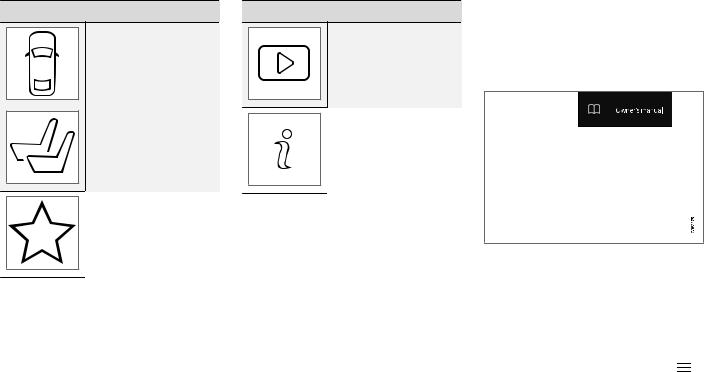
INTRODUCTION
||Symbols and their descriptions
Exterior/interior views of the vehicle in which certain areas/components are highlighted as hotspots. Tap a hotspot to come to a relevant article.
This offers access to a list of articles that have been saved as favorites. Tap an article to read it in its entirety.
Symbols and their descriptions
Leads to short instructional videos for various vehicle functions.
This offers information about the current version of the owner's information in your vehicle and other useful information.
Related information
•Navigating in the digital owner's manual (p. 16)
Navigating in the digital owner's manual
The digital on-board owner's manual is accessed from the center display. The contents are searchable and it is easy to navigate among the various sections.
The digital on-board owner's manual is accessed from the center display's Top view
Opening the digital owner's information
–To open the digital owner's information, pull down the center display's Top view and tap
Owner's manual.
There are several ways of finding information.
To access the owner's manual's menu, tap in the upper bar.
16
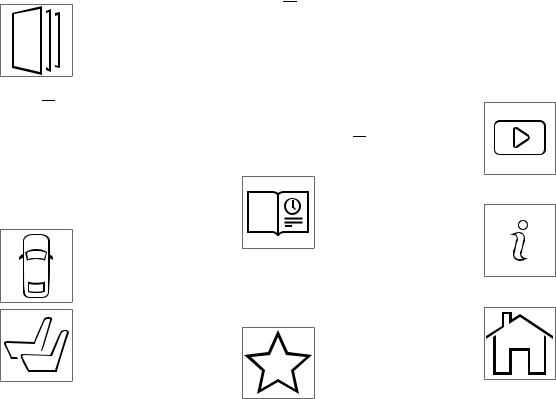
Searching using categories
The articles in the owner's manual are structured in main and sub-categories. The same article may appear in several pertinent categories in order to make them easier to find.
1.Tap  followed by Categories.
followed by Categories.
>The main categories will be listed.
2.Tap a main category ( ).
).
>A list of sub-categories and ( ) and articles (
) and articles (  ) will be displayed.
) will be displayed.
3.Tap an article to open it. Tap the left arrow to go back.
Interior and exterior hotspots
Exterior and interior views of the vehicle where certain components are pointed out are called hotspots.
1.Tap  followed by Exterior/Interior.
followed by Exterior/Interior.
>Exterior/interior views will be displayed with hotspots, which lead to relevant articles. Swipe the screen horizontally to scroll among the views.
2.Tap a hotspot.
>The title of a relevant article will be displayed.
3.Tap the title to open the article. Tap the left
arrow to go back or  to begin a new search.
to begin a new search.
Quick Guide
The heading Quick Guide in the owner's manual's menu
leads to a selection of articles
that may be helpful in familiarizing you with your vehicle's most common features and functions. These articles can also
be found through categories but have been gathered here for quick access. Tap an article to read it in its entirety.
Favorites |
This is a list of articles that have been saved as favorites. Tap an article to read it in its entirety.
INTRODUCTION
Saving/deleting favorites
Save an article as a favorite by tapping the star ( ) at the upper right when an article is open.
) at the upper right when an article is open.
The star symbol will be filled in ( ) when its article has been saved as a favorite.
) when its article has been saved as a favorite.
To delete a favorite, tap its star again.
Video
Tap for short instructional videos for various vehicle functions.
Information
Start page
Tap the symbol for information about the current version of the owner's information in your vehicle and other useful information.
Tap the symbol to come to the owner's information start page.
}}
17
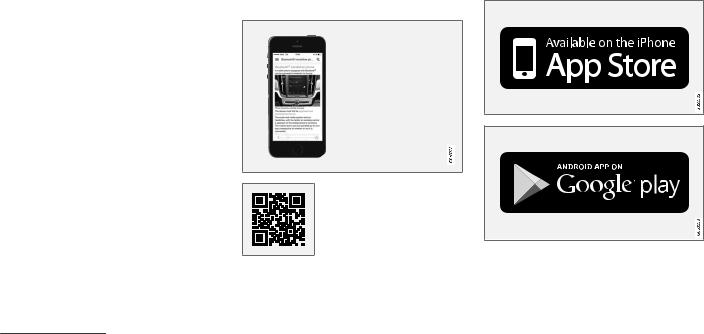
INTRODUCTION
||Using the search function
1.Tap the magnifying glass icon ( ) in the owner's manual's upper menu. A keyboard will appear at the bottom of the screen.
) in the owner's manual's upper menu. A keyboard will appear at the bottom of the screen.
2.Enter a word, e.g., "seat belt."
>Suggested articles will be displayed as more characters are entered.
3.Confirm by tapping the article. To leave search mode tap the up-arrow next to the search box.
Related information
•On-board digital owner's manual (p. 15)
•Using the center display keyboard (p. 47)
Owner's manual in mobile devices
Owner's information mobile app1 can be downloaded from the App Store and Google Play and is adapted for both cell phones and tablets.
These apps also contain videos and interior/ exterior hotspot views of the vehicle that you can click on for additional information.
This QR code will take you directly to the app or you can search for "Volvo manual" in the App Store or Google Play.
The app contains videos and exterior/interior views of the vehicle with certain components/ functions highlighted in hotspots, which lead directly to related information. It is easy to navigate between the various categories and articles and the contents are searchable.
The mobile app is available at the App Store and Google Play
1 Certain models and mobile devices
18
Related information
•Using the owner's manual (p. 20)
•Additional information about your vehicle (p. 19)
Additional information about your vehicle
Volvo Cars' website and support site provide additional information about your vehicle.
Support on the Internet
Go to support.volvocars.com to visit the site, which is available in most markets.
The information on the support site is searchable and is grouped into different categories. It includes support for e.g., Internet-based services and functions, Volvo On Call, the navigation system and apps. Video and step-by-step instructions explain various procedures such as how to connect the vehicle to the Internet via a cell phone.
Downloadable information
Maps
Sensus Navigation system maps can be downloaded from the support site.
Mobile apps
Beginning with model year 2014, the owner's manual is available in the form of an app for certain Volvo models. The Volvo On Call app can also be found here.
Owner's manuals for earlier model Volvos
Owner's manuals for earlier model Volvos are available in PDF format. Quick Guides and supplements can also be found on the support site.
INTRODUCTION
Select a model and a model year and download the desired information.
Contact
Contact information for customer support and the nearest Volvo retailer are available on the site.
Related information
•Using the owner's manual (p. 20)
•On-board digital owner's manual (p. 15)
•Volvo ID (p. 25)
19
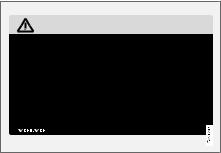
INTRODUCTION
Using the owner's manual
Reading your owner's manual is a good way of familiarizing yourself with the features and systems in your vehicle.
On-board owner's manual
Reading the owner's manual is a good way to become familiar with your vehicle and to learn to utilize the features and functions that it offers. Pay particular attention to the warnings provided.
Volvo reserves the right to make model changes at any time, or to change specifications or design without notice and without incurring obligation.
© Volvo Car Corporation
Printed owner's information
We advise keeping printed owner's information in the vehicle for quick access to necessary information and how to contact Volvo if help is required.
Illustrations
Some of the illustrations and images used in your owner's information may be generic and are intended to provide a general view or an example of a certain feature or function. The features or functions in the illustrations may differ slightly from the equipment in your vehicle depending on the level of instrumentation or market.
Options and accessories
Optional or accessory equipment described in this manual is indicated by an asterisk.
Optional or accessory equipment may not be available in all countries or markets. Please note that some vehicles may be equipped differently, depending on special legal requirements.
Contact your Volvo retailer for additional information.
Footnotes
Certain pages of this manual contain information in the form of footnotes at the bottom of the page. This information supplements the text that the footnote number refers to (a letter is used if the footnote refers to text in a table).
Messages
There are several displays in the vehicle that show messages generated by various systems and functions in the vehicle. The appearance of these texts differs slightly from normal texts (for example: Phone, Accept).
Decals
There are various types of decals in the vehicle whose purpose is to provide important information in a clear and concise way. The importance of these decals is explained as follows, in descending order of importance.
Risk of injury
Black ISO symbols on a yellow warning background, white text/image on a black background. Decals of this type are used to indicate potential danger. Ignoring a warning of this type could result in serious injury or death.
20
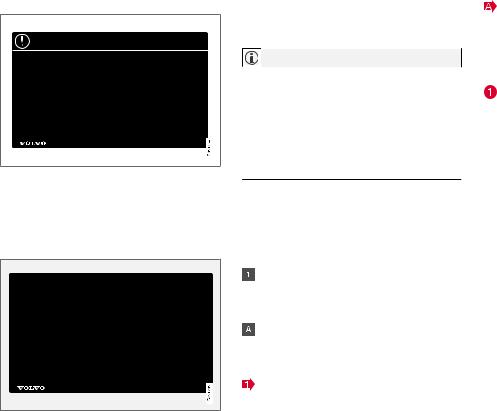
Risk of damage to the vehicle
White ISO symbols and white text/image on a black or blue warning background and space for a message. If the information on decals of this type is ignored, damage to the vehicle could result.
Information
White ISO symbols and white text/image on a black background. These decals provide general information.
NOTE
The decals shown in the Owner’s Manual are examples only and are not intended to be reproductions of the decals actually used in the vehicle. The purpose is to give an indication of how they look and their approximate location in the vehicle. The applicable information for your particular vehicle can be found on the respective decals in the vehicle.
Types of lists
Procedures
Procedures (step-by-step instructions), or actions that must be carried out in a certain order, are arranged in numbered lists in this manual.
If there is a series of illustrations associated with step-by-step instructions, each step in the procedure is numbered in the same way as the corresponding illustration.
Lists in which letters are used can be found with series of illustrations in cases where the order in which the instructions are carried out is not important.
Arrows with or without numbers are used to indicate the direction of a movement.
INTRODUCTION
Arrows containing letters are used to indicate movement.
If there are no illustrations associated with a step-by-step list, the steps in the procedure are indicated by ordinary numbers.
Position lists
Red circles containing a number are used in general overview illustrations in which certain components are pointed out. The corresponding number is also used in the position list's description of the various components.
Bullet lists
Bullets are used to differentiate a number of components/functions/points of information that can be listed in random order.
For example:
•Coolant
•Engine oil
Related information
Related information offers references to articles containing information associated with the information that you are currently reading.
Continues on next page
} }This symbol can be found at the lower right corner to indicate that the current topic continues on the following page.
}}
21
INTRODUCTION
||Continuation from previous page
|| This symbol can be found at the upper left corner to indicate that the current topic is a continuation from the previous page.
Related information
•On-board digital owner's manual (p. 15)
•Owner's manual in mobile devices (p. 18)
•Additional information about your vehicle (p. 19)
Crash event data
This vehicle is equipped with an event data recorder (EDR). The main purpose of an EDR is to record, in certain crash or near crash-like situations, such as an air bag deployment or hitting a road obstacle, data that will assist in understanding how a vehicle's systems performed. The EDR is designed to record data related to vehicle dynamics and safety systems for a short period of time, typically 30 seconds or less. The EDR in this vehicle is designed to record such data as:
•How various systems in your vehicle were operating;
•Whether or not the driver and passenger safety belts were buckled/fastened;
•How far (if at all) the driver was depressing the accelerator and/or brake pedal; and,
•How fast the vehicle was traveling.
These data can help provide a better understanding of the circumstances in which crashes and injuries occur.
EDR data are recorded by your vehicle only if a non-trivial crash situation occurs; no data are recorded by the EDR under normal driving conditions and the EDR never registers who is driving the vehicle or the location of a crash or a near crash-like situation. However, other parties, such as law enforcement, could combine the EDR data with the type of personally identifying data rou-
tinely acquired during a crash investigation. To read data recorded by an EDR, special equipment is required, and access to the vehicle or the EDR is needed.
Furthermore, your vehicle is equipped with a number of computers whose task is to continuously control and monitor the vehicle’s operation. They can also register some of this information during normal driving conditions, most importantly if they detect a fault relating to the vehicle’s operation and functionality or upon activation of the vehicle’s active safety systems (e.g. City Safety and the auto-brake function). Some of the registered information is required by technicians when carrying out service and maintenance to enable them to diagnose and rectify any faults that have occurred in the vehicle and to enable Volvo to fulfill legal and other regulatory requirements. Information thus registered in the vehicle is registered in the vehicle’s computers until the vehicle is serviced or repaired. In addition to the above, the registered information may – on an aggregated basis – be used for research and product development purposes in order to continuously improve the safety and quality of Volvo vehicles.
For additional information, contact:
In the United States
Volvo Car USA, LLC
Customer Care Center
1 Volvo Drive, P.O. box 914
22

Rockleigh, New Jersey 07647 1-800-458-1552 www.volvocars.com/us
In Canada
Volvo Car Canada Ltd.
Customer Care Centre
9130 Leslie Street
Richmond Hill, Ontario L4B 0B9 1-800-663-8255 www.volvocars.com/ca
Options, accessories and the Onboard Diagnostic (OBDII) socket
We strongly recommend that Volvo owners install only genuine, Volvo-approved accessories, and that accessory installations be performed only by a trained and qualified Volvo service technician.
Optional or accessory equipment described in this manual is indicated by an asterisk.
Optional or accessory equipment may not be available in all countries or markets. Please note that some vehicles may be equipped differently, depending on special legal requirements.
Contact your Volvo retailer for additional information.
INTRODUCTION
NOTE
•Do not export your Volvo to another country before investigating that country's applicable safety and exhaust emission requirements. In some cases it may be difficult or impossible to comply with these requirements. Modifications to the emission control system(s) may render your Volvo not certifiable for legal operation in the U.S., Canada and other countries.
•All information, illustrations and specifications contained in this manual are based on the latest product information available at the time of publication. Please note that some vehicles may be equipped differently, depending on market-specific adaptations or special legal requirements. Optional equipment described in this manual may not be available in all markets.
•Some of the illustrations shown are generic and are intended as examples only, and may not depict the exact model for which this owner's information is intended.
•Volvo reserves the right to make model and product changes at any time, or to change specifications or design without notice and without incurring obligation.
}}
23
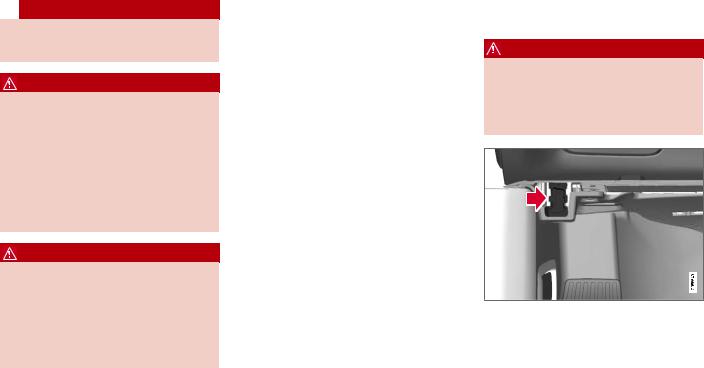
INTRODUCTION
|| WARNING
WARNING
If your vehicle is involved in an accident, unseen damage may affect its drivability and safety.
WARNING
CALIFORNIA proposition 65
Engine exhaust, some of its constituents, and certain vehicle components contain or emit chemicals known to the state of California to cause cancer, and birth defects or other reproductive harm. In addition, certain fluids contained in vehicles and certain products of component wear contain or emit chemicals known to the State of California to cause cancer, and birth defects or other reproductive harm.
WARNING
Certain components of this vehicle such as air bag modules, seat belt pretensioners, adaptive steering columns, and button cell batteries may contain Perchlorate material. Special handling may apply for service or vehicle end of life disposal.
See www.dtsc.ca.gov/hazardouswaste/ perchlorate.
•Genuine Volvo accessories are tested to ensure compatibility with the performance, safety, and emission systems in your vehicle.
Additionally, a trained and qualified Volvo service technician knows where accessories may and may not be safely installed in your Volvo. In all cases, please consult a trained and qualified Volvo service technician before installing any accessory in or on your vehicle.
•Accessories that have not been approved by Volvo may or may not be specifically tested for compatibility with your vehicle. Additionally, an inexperienced installer may not be familiar with some of your car's systems.
•Any of your car's performance and safety systems could be adversely affected if you install accessories that Volvo has not tested, or if you allow accessories to be installed by someone unfamiliar with your vehicle.
•Damage caused by unapproved or improperly installed accessories may not be covered by your new vehicle warranty. See your Warranty and Service Records Information booklet for more warranty information. Volvo assumes no responsibility for death, injury, or expenses that may result from the installation of nongenuine accessories.
Connecting equipment to the On-board Diagnostic (OBDII) socket
WARNING
Volvo Cars takes no responsibility for the consequences of connecting non-authorized equipment to the On-board Diagnostic (OBDII) socket. This socket should only be used by a trained and qualified Volvo service technician.
The diagnostic socket OBDII under the dashboard on the driver's side
24

Type approval
USA
FCC ID: 2AGKKACUII-06
This device complies with Part 15 of the FCC rules. Operation is subject to the following two conditions:
(1)This device may not cause harmful interference, and
(2)this device must accept any interference received, including interference that may cause undesired operation.
WARNING
Changes or modifications not expressly approved by the party responsible for compliance could void the user's authority to operate the equipment.
Canada
IC: 20839-ACUII06
This device complies with Industry Canada licence-exempt RSS standard(s). Operation is subject to the following two conditions:
(1)this device may not cause interference, and
(2)This device must accept any interference received, including interference that may cause undesired operation.
Volvo ID
A Volvo ID can be used to access a number of online services2
Creating a Volvo ID
A Volvo ID can be created in two ways:
Using the Volvo ID app
1.If you have not already done so, download the Volvo ID app from the Download Center.
2.Start the app and register a personal email address.
3.Follow the instructions that will be sent automatically to this email address.
>A Volvo ID has now been created and has been automatically registered to the vehicle. The Volvo ID services available can now be used.
Using the Volvo On Call app
1.Download the latest version of the Volvo On Call app to your cell phone from e.g., the App Store, Windows Phone or Google Play.
2.Start the app and create a Volvo ID on the start page.
3.Register a personal email address and then follow the instructions that will be sent automatically to this address.
2 These services vary and may be subject to change. Consult your Volvo retailer.
INTRODUCTION
Registering your Volvo ID to the vehicle
If your Volvo ID was created using the Volvo On Call mobile app, the ID has to be registered to the vehicle:
1.With the vehicle connected to the Internet, download the Volvo ID app from the Download Center in the center display's App view. See also the article "Downloading, updating and uninstalling apps."
2.Start the app and enter your Volvo ID.
3.Follow the instructions that will be sent automatically to the email address linked to your Volvo ID.
>Your Volvo ID is now registered to the vehicle and the Volvo ID services available can be used.
Advantages of having a Volvo ID
•Only one user name and password are required to access online services.
•If you change a user name or password for one of the online service (e.g., Volvo On Call), it/they will also be automatically changed for the other services.
Related information
•Downloading, updating and uninstalling apps (p. 454)
•Connecting to the Internet (p. 450)
25
INTRODUCTION
Volvo and the environment
Volvo is committed to the well-being of its customers. As a natural part of this commitment, we care about the environment in which we all live. Concern for the environment means an everyday involvement in reducing our environmental impact.
Volvo's environmental activities are based on a holistic view, which means we consider the overall environmental impact of a product throughout its complete life cycle. In this context, design, production, product use, and recycling are all important considerations. In production, Volvo has partly or completely phased out several chemicals including CFCs, lead chromates, asbestos, and cadmium; and reduced the number of chemicals used in our plants 50% since 1991.
Volvo was the first in the world to introduce into production a three-way catalytic converter with a Lambda sond, now called the heated oxygen sensor, in 1976. The current version of this highly efficient system reduces emissions of harmful substances (CO, HC, NOx) from the exhaust pipe by approximately 95 – 99% and the search to eliminate the remaining emissions continues. Volvo is the only automobile manufacturer to offer CFC-free retrofit kits for the air conditioning system of all models as far back as the 1975 model 240. Advanced electronic engine controls and cleaner fuels are bringing us closer to our goal. In addition to continuous environmental
refinement of conventional gasoline-powered internal combustion engines, Volvo is actively looking at advanced technology alternative-fuel vehicles.
When you drive a Volvo, you become our partner in the work to lessen the car's impact on the environment. To reduce your vehicle's environmental impact, you can:
•Maintain proper air pressure in your tires. Tests have shown decreased fuel economy with improperly inflated tires.
•Follow the recommended maintenance schedule in your Warranty and Service Records Information booklet.
•Drive at a constant speed whenever possible.
•See a trained and qualified Volvo service technician as soon as possible for inspection if the check engine (malfunction indicator) light illuminates, or stays on after the vehicle has started.
•Properly dispose of any vehicle-related waste such as used motor oil, used batteries, brake pads, etc.
•When cleaning your vehicle, please use genuine Volvo car care products. All Volvo car care products are formulated to be environmentally friendly.
Related information
•Driving economically (p. 399)
IntelliSafe—driver support
IntelliSafe is Volvo's philosophy regarding vehicle safety. It encompasses a number of systems, both standard and optional, that are designed to help make driving and traveling in a Volvo safer.
Support
Systems that help make driving safer are an integral part of IntelliSafe. These include optional features such as Adaptive Cruise Control* that helps maintain a set distance to a vehicle ahead, Park Assist Pilot*, which assists in parking the vehicle, Cross Traffic Alert*, Blind Spot Information*, etc.
Accident prevention
Systems such as City Safety are designed to automatically apply the brakes in situations in which the driver does not have time to react.
Lane Keeping Aid* alerts the driver if the vehicle inadvertently crosses a lane's/road's side marker line.
Protection
The vehicle is equipped with e.g., seat belt pretensioners that pull the seat belts taut in critical situations when there is a collision risk and numerous airbags designed to help provide cushioning if certain types of collisions should occur.
Related information
•Adaptive Cruise Control (ACC)* (p. 270)
•Park Assist Pilot (PAP)* (p. 356)
26 |
* Option/accessory. |
INTRODUCTION
•High and low beam headlights (p. 141)
•Cross Traffic Alert (CTA)* (p. 321)
•Blind Spot Information (BLIS)* (p. 319)
•City Safety™ (p. 307)
•Driving lane assistance (p. 330)
•Airbag system (p. 67)
•Roll stability control (RSC) (p. 253)
•Seat belts (p. 62)
•General safety information (p. 58)
* Option/accessory. 27
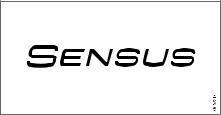
INTRODUCTION
Sensus
Sensus is the core of your personal Volvo experience and provides information, entertainment and features that make owning your vehicle easier.
This is Sensus
Sensus provides an intelligent interface and Internet-connected service with an intuitive navigation structure that offers access to relevant information when it is needed, with minimal distractions.
Sensus also includes all of your vehicle's solutions relating to entertainment, connecting to the Internet, navigation and the user interface between the driver and the vehicle. Sensus makes communication between you, the vehicle and the digital world around you possible.
28
